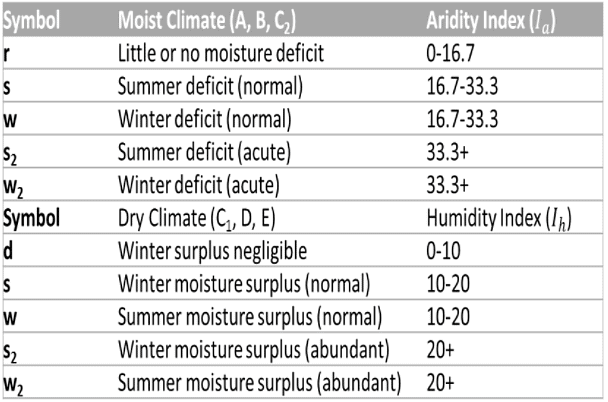Koppen’s , Thornwaite’s & Trewar Tha’s Classification of World’s Climate | Geography Optional for UPSC (Notes) PDF Download
Koppen Climate Classification System
- The Koppen Climate Classification System is the most widely used modern climate classification system. It was developed by Wladimir Köppen, a Russian-German climatologist, who sought to classify the world's climates by examining the close relationship between vegetation and climate in different regions. His goal was to create a chart with formulas and notations that would accurately define climatic boundaries based on the existing vegetation in the area.
- In simpler terms, Köppen studied the trees and plants in various regions and determined the relationship between the vegetation and the climate of those areas. Using this information, he established a chart that categorized different climates into groups, along with their defining traits.
- To achieve this, Köppen selected specific temperature and precipitation values, relating them to the distribution of vegetation. He then used these values to classify the climates. The resulting system classifies the world's climates using capital letters - A, B, C, D, E, and H. These categories are further subdivided into types and subdivisions using lowercase letters - a, b, c, d, h, f, m, w, k, and s.
- Before delving deeper into the Koppen Climate Classification System, it's essential to understand the difference between weather and climate.
Differences between weather and climate

Wladimir Köppen (1846-1940) was a German climatologist of Russian origin who also had a keen interest in botany. He developed a climate classification system, with the first version introduced in 1918. Throughout his life, Köppen continued to make adjustments and improvements to the system, with the final version published in 1936.
The modified Köppen classification system comprises five primary climate groups, labeled A, B, C, D, and E. These groups are further divided into a total of 14 distinct climate types, as well as an additional category for highland (H) climates.

Climate Groups According to Koeppen
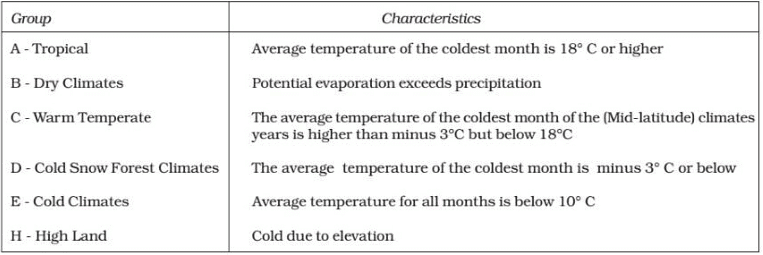
Climatic Types According to Koeppen
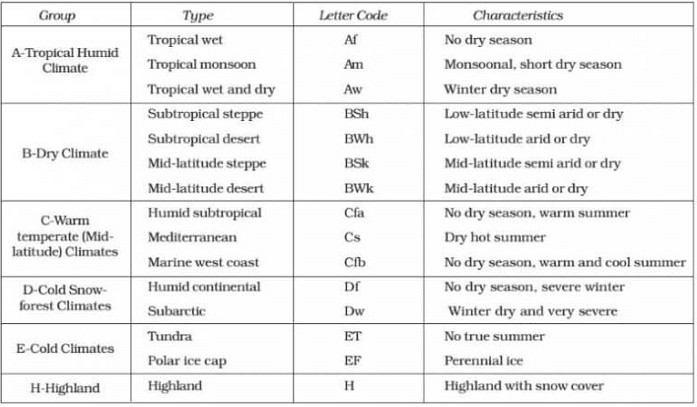
- Koeppen recognized five major climatic groups, four of them are based on temperature and one on precipitation.
- The capital letters:
- A, C, D, and E delineate humid climates and
- B dry climates
- The climatic groups are subdivided into types, designated by small letters, based on seasonality of precipitation and temperature characteristics.
- The seasons of dryness are indicated by the small letters: f, m, w, and s, where
- f – no dry season,
- m – monsoon climate,
- w – winter dry season and
- s – summer dry season.
- The above mentioned major climatic types are further subdivided depending upon the seasonal distribution of rainfall or degree of dryness or cold.
- a: hot summer, the average temperature of the warmest month over 22°C
- c: cool summer, the average temperature of the warmest month under 22°C
- f: no dry season
- w: the dry season in winter
- s: the dry season in summer
- g: Gange’s type of annual march of temperature; hottest month comes before the solstice and the summer rainy season.
- h: average annual temperature under 18°C
- m (monsoon): short dry season.
- The capital letters S and W are employed to designate the two subdivisions of dry climate
- semi-arid or Steppe (S) and
- arid or desert (W).
- Capital letters T and F are similarly used to designate the two subdivisions of polar climate
- tundra (T) and
- icecap (F).

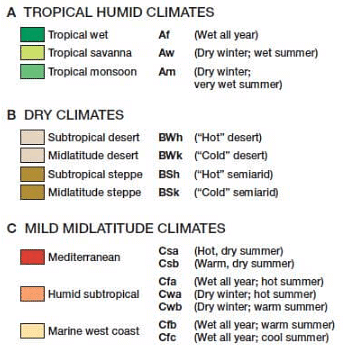
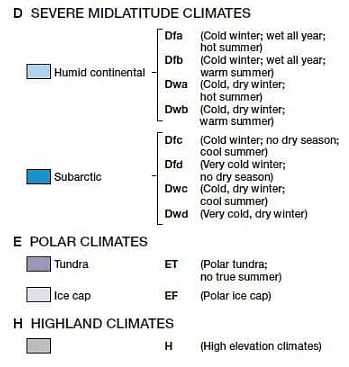
Thornthwaite Climatic Classification
C. W. Thornthwaite, an American climatologist, first introduced his climatic classification system for North America in 1931 when he published a climatic map of the continent. He later expanded this classification system to cover global climates and presented his complete scheme in 1933. Thornthwaite further revised and modified his system, releasing a second version in 1948, which included the concept of potential evapotranspiration. His classification system is considered complex and empirical.
Initially, Thornthwaite's classification scheme resembled Köppen's system, as both believed that vegetation is an indicator of climate type. Thornthwaite's system is primarily based on two key factors: precipitation effectiveness (P/E, where P represents total monthly precipitation and E represents total monthly evaporation) and temperature efficiency.
Using these two indicators, Thornthwaite divided the world into five humidity regions:
A: Very Humid Rainforest - regions characterized by abundant rainfall and high humidity, supporting lush vegetation.
B: Humid Forest - regions with significant rainfall and humidity, enabling the growth of dense forests.
C: Semi-Humid Grassland - areas with moderate rainfall and humidity levels, resulting in grassy landscapes rather than dense forests.
D: Semi-Dry Steppe - regions with limited rainfall and lower humidity, leading to sparse vegetation and steppe landscapes.
E: Dry Desert - areas with extremely low rainfall and humidity, resulting in arid desert environments with minimal vegetation.
Each region had its own special type of vegetation as shown in the table below:

Design of Thornthwaite Climatic Classification
Thornthwaite’s design of climate classification is a combination of three letter alphabets.
- The first alphabet used in the major climatic classification is any one of the English capital letters from A to E.
- The second letter used in the climatic classification is also an English capital alphabet superscript with a dash. It denotes thermal provinces.
- The third letter in a combination of alphabets is denoted by a set of 8 small English alphabets.
Precipitation effectiveness
- Plants’ growth is not only dependent on precipitation but precipitation effectiveness.
- Precipitation effectiveness P/E ratio=total monthly precipitation/ Evapotranspiration P/E index= sum of 12 month P/E ratio.
- Based on the P/E index, Thornthwaite classified five humidity region:
- A: ( P/E index>128) – Wet-Rainforest.
- B: ( P/E Index 64 to 127) – Humid-Forest
- C: ( P/E index 32 to 63) – Subhumid-Grassland.
- D: (P/E index 16-32) – Semi Arid-Steppe
- E: (P/E index less than 16) – Arid-Desert
On the basis of precipitation effectiveness, thermal efficiency, and seasonal distribution of rainfall there may be 120 probable combinations and hence climatic types on the theoretical ground but he depicted only 32 climatic types on the world.
- On the basis of the distribution of seasonal rainfall the above types of humidity regions were further divided into the following subdivisions:
r = Heavy rainfall in all seasons
s = Scarcity of rainfall in the summer season
w = Scarcity of rainfall in the winter season
d = Scarcity of rainfall in all seasons
Aridity index for humid climates
(i) Moisture deficit acute during winter = w2
(ii) Moisture deficit acute during summer =s2
Humidity index for arid climates
(i) Moisture surplus abundant during winter =s2
(ii) Moisture surplus abundant during summer = w2
Temperature efficiency
- Temperature efficiency is calculated mean average temperature of through years.
- Based on Temperature efficiency – Thornthwaite has divided the world into six thermal provinces. They are expressed as:
- A’ — tropical: (T/E index more than 128).
- B’ — Subtropical: (T/E index 64-127).
- C’ — Temperate: (T/E index 32 – 63)
- D‘ — Taiga: (T/E index 16-31)
- E’ — Tundra: (T/E index 1-15).
- F’ — Frost: (T/E index 0).
Thornthwait was being criticized for making climatic classification complex. To make it simple, Thornthwait gave the evapotranspiration concept to derive a climatic region in 1948.
Evapotranspiration: Combined, evaporation from the soil and transpiration from vegetation is called Evapotranspiration.
- The modified Thornthwaite system (1948) is a climatic classification system that is based on the concept of potential evapotranspiration (PE), which estimates the water use of plants with an unlimited water supply. This system differs from Thornthwaite's 1931 classification, where he focused on vegetation instead of potential evapotranspiration.
- In this updated system, Thornthwaite used three indices to classify climates: precipitation effectiveness, thermal efficiency, and seasonal distribution of precipitation. However, these indices were used differently than in his earlier classification.
- Potential evapotranspiration (PE) is an important concept in this system as it represents the amount of water and heat transferred to the atmosphere from soils and vegetation (through evaporation and transpiration). This process is directly related to the amount of energy received from the sun, making it an index of thermal efficiency and water loss.
- In summary, the modified Thornthwaite system (1948) is a climatic classification scheme that focuses on potential evapotranspiration as a key concept, using it as an index of thermal efficiency and water loss. This system relies on three indices – precipitation effectiveness, thermal efficiency, and seasonal distribution of precipitation – to classify climates, with a unique emphasis on potential evapotranspiration as a critical factor.
Index in modified method
- Aridity Index (Ia)
- Humidity Index (Ih)
- Soil Moisture Index (Im)
if: PET >Precipitation = Soil Moisture 0/-ve
if: Precipitation > PET = Soil Moisture +ve
- Moist Climate determined by Aridity Index (variability in summer and winter)
- Dry climate determined by Moisture Index



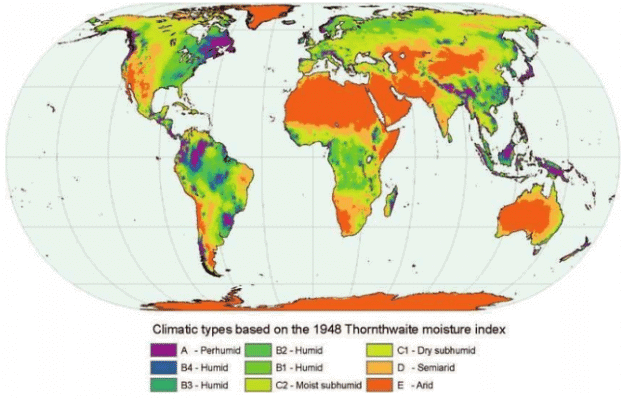
Criticism of the Thornthwaite Climatic Classification
Thornthwaite's Climatic Classification has made significant qualitative improvements in categorizing global climates. However, the system has faced several criticisms due to various shortcomings in its approach and applicability.
- One of the main criticisms is that Thornthwaite's classification does not take into account factors such as prevailing winds, relative humidity, air pressure, and air masses, which play a crucial role in determining the climate of a region. Additionally, the system fails to consider the influence of relief and the position of the sun concerning the incidence of solar radiation on Earth.
- While the classification has been found to be satisfactory in North America, where vegetation boundaries align well with specific precipitation-to-evapotranspiration (P/E) values, it falls short in accurately classifying tropical and semi-arid regions. This is partly due to the complexity of calculating soil moisture balance for different natural regions and vegetation zones, which can lead to a lack of clarity in the classification system.
- Another significant issue is the limited availability of data on meteorological variables, both in terms of time and geographical coverage. This data scarcity poses a challenge in applying Thornthwaite's classification system to various regions worldwide.
- Furthermore, the complex nature of the classification system has made it less widely used and of limited application. Researchers and practitioners often find it difficult to navigate and apply the system to analyze and classify various climatic conditions.
- Lastly, Thornthwaite's Climatic Classification does not address contemporary issues such as global warming, climate change, and the increasing frequency of extreme weather events. As these issues become increasingly important in understanding and managing our global climate, the limitations of the Thornthwaite system become more apparent.
In conclusion, although Thornthwaite's Climatic Classification has made strides in improving the categorization of world climates, it still faces several criticisms and limitations that need to be addressed for it to be more widely used and applicable in today's changing climate.
Thornthwaite climatic division of India
The following are the climatic division of India as per the Thornthwaite concept of Evapotranspiration.
- Per Humid( A) region of India
- Western Ghats
- Most parts of the NorthEastern States
- Humid(B) region of India
- Adjoining region of the Perhumid region
- Moist Sub Humid(C1) climatic region
- Narrow belt Adjoining region of the humid region of Western Ghats.
- Eastern India comprises of West Bengal and Orissa
- Dry Sub Humid(C2) regions
- Northern Narrow belt of the Ganga basin.
- Part of Uttar Pradesh, Bihar, MP, Chhattisgarh, Jharkhand
- Western Maharastra and Southern Gujarat
- Semi-Arid(D) climatic region
- Part of Punjab and Haryana
- Eastern part of Rajasthan, Maharashtra, Karnataka, Lenangna
- Western Pat of Tamilnadu.
- Arid climatic( E) region of India:
- Western Rajasthan
- Western Himalayan
- Rainshadow zone of western Ghats
Trewartha Climatic Classification
The Trewartha climate classification is a system for categorizing climates, developed by American geographer Glenn Thomas Trewartha in 1966. This classification is considered a modified version of the Koeppen system and aims to be simpler and more explanatory. Trewartha's approach combines elements from both empirical and genetic classification schemes, making it more accessible and easier to understand.- Trewartha was aware that the classification systems of Koeppen and Thornthwaite, which were based on specific statistical parameters of weather elements, were complex and difficult to use. As a result, he chose to focus on a limited number of primary climate types in his classification system. Trewartha's classification is primarily based on two fundamental weather elements: temperature and precipitation. Additionally, he considered the effects of land and water surfaces on the climate of a particular area.
- Trewartha's climate classification system includes seven climate groups, six of which (A, C, D, E, F, and H) are based on temperature criteria. The overall goal of this classification system is to provide a more straightforward and comprehensible method for categorizing and understanding the world's various climates.
- Group A: Tropical climates
- Group C: Subtropical climates
- Group D: Temperate and continental climates
- Group E: Boreal climates
- Group F: Polar climates
- Group H: Highland climates
the seventh- B: is the dry group based on precipitation.
- Group B: Dry (arid and semi-arid) climates

Climatic Groups Based on Temperature Criteria
Group A
- This is the tropical climate group.
- This type of climate is found in the low latitudes on each side of the equator in an irregular belt 20° to 40° wide.
- There is – no winter season in-this climatic-group.
- Temperature is uniformly high throughout the year with adequate annual rainfall.
- In marine areas, the average temperature for the coldest month is around 18°C to 20°G.
- This climatic group is subdivided into two climatic types:
(i) Ar
(ii) Aw
1. Ar
- Ar. is a tropical wet climate.
- This type of climate is characterized by less than two dry months.
- The climate is under the influence of the intertropical convergence zone and the equatorial westerlies.
- The belt is distinguished by constant low pressure and is also known as the tropical rainforest.
2. Aw
- Aw is a tropical wet-and-dry climate.
- At the time of the low sun, two months are usually dry.
- The climatic regions are dominated by the dry trade winds or subtropical anticyclones.
- During the high sun period, the equatorial westerlies and intertropical convergence control the weather.
- The duration of the dry season is usually longer than that of the wet season.
- The temperature remains uniformly high in this type of climate.
Group C
- This category encompasses subtropical climate with temperatures above 10 °C for only eight or more months.
- Frosts occur occasionally in continental parts, but the marine locations remain frostless,
On the basis of the seasonal distribution of precipitation, the subtropical climate is further classified into two climatic types
- Cfw
- Cs
- Cfw
- Cfw. is a sub-tropical humid climate.
- This type of climate is found on the eastern side of continents.
- It has no distinct dry season and rains fall throughout the year.
- During the summer season, this type of climate comes under the influence of unstable air in the western end of a subtropical anticyclone.
- But & ring winter, the climate is influenced by temperate cyclones.
- Cs
- Cs. is a sub-tropical dry summer climate.
- It is characterized by a moderate to scanty amount of precipitation.
- Winter is the rainy season, while summers are nearly or completely dry.
- This climate type represents a transition zone between the tropical dry climates towards the equator and the temperate climates towards the poles.
- The average annual precipitation is less than 890 mm (35 inches).
Group D
- This group represents temperate climates.
- The climatic group is also known as the micro-thermal climatic type.
- The average temperature is around 10 °C for 4 to 8 months.
- This type of climate is found in the middle latitudes between the sub-tropical and boreal climates.
- The two types of climate that are included in the temperate group of humid climates are:
(i) Do
(ii) Dc
- Do
- Do. is temperate marine climate.
- With mild winters, the average temperature for all the 12 months is 0 °C or above.
- A humid climate with adequate precipitation at all seasons, it is found on the western windward side of the continents in the temperate zone.
- Dc
- Dc. is a temperate continental climate found in the continental interiors of the middle-latitude continents.
- The climate is basically land-controlled.
- The climatic type is characterized by severe winters and summers.
- Annual temperature ranges are, therefore, high throughout this climate, Cold waves, heat waves, blizzards, and heavy downpours are all yearly events in this category, of climate.
- Precipitation occurs throughout the year with maximum concentration during summers.
Group E
- The group represents sub-arctic or boreal climate found in the higher middle latitudes.
- Super-continental in temperate features, here the summers are short and comparatively cool.
- The winters are, however, long and very cold with a very short frost-free season.
- The average temperature hovers around 10 °C for one to three months during the year.
- The rest of the year has an average temperature below 10 °C.
- These regions are characterized by the lowest annual means of temperature for any part of the earth.
- Even though boreal climates are classified as humid, annual precipitation is comparatively very less.
- Precipitation occurs throughout the year, most during the warmer months when the amount of water vapour present in the air is highest.
- Because of the severity of climate, the population is sparse.
Group F
- The group consists of polar climate found in the high latitudes.
- The climate is confined to the northern hemisphere only.
- The average temperature in this type of climate seldom exceeds -1O °C.
- There is no summer season.
The polar climates are classified into the following two climatic types:
- Ft
- Ft. is Tundra climate found only in the northern hemisphere, where it occupies the coastal sides of the Arctic Ocean, and many Arctic islands and ice-free shores of northern Iceland and southern Greenland.
- No tundra climate is found in the southern hemisphere because of the complete absence of extensive land areas.
- The Tundra region, essentially a region of grasses, mosses, and lichen, is characterized by the absence of trees. The average temperature of the warmest month is recorded between 0 °C and 10 °C.
- Fi
- Fi. is an ice-cap climate in which the average temperature for all the months is below freezing.
- There is no vegetation of any kind. The land is permanently covered with ice and snow.
- The climate is exclusively confined to the ice-caps of Greenland and Antarctica.
Group H
- The group represents highland climates in which altitude plays a role in determining climate classification.
- The temperature under normal conditions decreases with altitude, with the summit area of a mountain being always cooler than its base.
- Windward slopes force the incoming air to rise up with the resultant condensation, cloud formation, and precipitation.
- The leeward slopes are characterized by descending air which is warmed up and produces little precipitation.
Trewartha says there is no such thing as a highland type of climate because various types of local climates exist in every significant mountain range. There are no typical temperature and rainfall regimes in the highland climates.
Climate Group based on Precipitation Criteria:
Group B
- This climatic group represents a dry environment, which is primarily defined by its low precipitation levels. The main characteristic of a dry climate is that the moisture lost through evapotranspiration significantly exceeds the annual water gained from precipitation.
- In a dry climate, the weather is typically clear and calm, with a dry atmosphere leading to larger temperature fluctuations throughout the year compared to other latitudes. These regions experience low rainfall, high potential evaporation, abundant sunshine, and minimal cloud cover, all factors that contribute to the classification of a Group B climate.
- In simpler terms, a dry climate is characterized by low rainfall and a significant difference between the amount of moisture lost and gained, resulting in a harsh and arid environment with extreme temperature variations.
They are further classified into two climatic groups.
- BW: BW is an arid or desert type of climate.
- BS: BS is a semi-arid or steppe type of classification.
BW and BS are further classified into the following subdivisions on the basis of temperature:
- BWh: BWh is tropical-subtropical hot deserts;
- BWK: BWK is temperate boreal cold deserts;
- BSh: BSh is tropical-boreal steppes; and
- BSk: BSk is temperate-boreal and cold.
The BWh and BWK climates are constantly dry and are under the influence of subtropical high and dry trades.
The BWh type of condition lasts for 8 months or more with an average temperature over 10 °C while the BWK lasts fewer than 8 months with an average temperature above 10 °C.
The BSh is characterized by a short moist season and is greatly influenced by subtropical high and dry trades.
The BSK type of climate receives most of its major annual precipitation during the warmer season.
Trewartha Climatic Classification of India
The Trewartha Climatic Classification system is a modified version of Köppen's classification, and it provides a fairly accurate representation of India's vegetation, agricultural, and geographical regions. In this system, four primary climatic categories (A, B, C, and H) are identified, which are further divided into seven distinct climatic types. This classification helps in better understanding the diverse climate patterns found across India.They are as follows:
- A: Tropical Rainy Climatic Group
- Am—Tropical Monsoon
- Aw—Tropical Savannah
- B: Dry Climatic Group
- BS—Tropical Steppe (semi-arid)
- Bsh—Sub-Tropical Steppe
- Bwh—Sub-Tropical Desert
- C: Humid Mesothermal Climatic Group
- Caw—Sub-Tropical Humid (Dry Winters)
- H: Mountain Climate
The climatic letters A, B, C, and H stand for the major groups of climate and the other letters designate the sub-divisions of major groups.
- A stands for the tropical rainy climate with persistently high temperature which is not less than 18° C in the coolest month.
- B is a dry climate of those regions where the rate of evaporation is more than the moisture received from precipitation.
- C represents humid sub-tropical or humid mesothermal climate.’ The temperature of the coldest month is between 18° C and 0° C.
- a – indicates hot summers with the warmest month having over 22° C temperature.
- h – is used when the mean annual temperature is 18° C.
- m – stands for heavy but seasonal monsoon rainfall; the dry period is very short.
- s – means steppe or semi-arid climate.
- w – stands for a desert.
The tropical monsoon type of climate (Am) is found over the Western Ghats, western Nagaland, and Tripura.
- The mean maximum and minimum temperatures here are 27° C and 18° C respectively.
- This region receives an annual rainfall of 250 cm.
The tropical savannah climate (Aw) covers almost the whole of Deccan Plateau except a narrow strip of the rain-shadow area in the east of the Western Ghats, north-eastern Guajrat, southern Madhya Pradesh, southern Bihar, Orissa, Andhra Pradesh and Tamil Nadu.
- This region receives, and an annual rainfall of 100 cm and the mean maximum temperature here is 45° C and the mean minimum temperature is 18° C.
The tropical steppe (semi-arid) type of climate (BS) covers interior Karnataka, central Maharashtra, western Andhra Pradesh, and interior Tamil Nadu.
- This region receives an annual rainfall of less than 75 cm and the mean maximum and means minimum temperatures here are 32° C and 23° C respectively.
The sub-tropical steppe (Bsh) type covers an area from Punjab to Kachchh, which is characterized by an annual rainfall that fluctuates between 50 cm and 75 cm.
- The mean maximum and mean minimum temperatures here are 46° C and 6° to 10° C respectively.
The sub-tropical desert type of climate (Bwh) prevails over western Rajasthan and Kachchh.
- This area receives a low annual rainfall of 12.5 cm and the mean maximum and mean minimum temperatures here are 48° C and 12° C respectively.
The sub-tropical humid (dry winters) type of climate (Caw) covers the Punjab foothills, Uttar Pradesh, Bihar, West Bengal, Assam, and Arunachal Pradesh.
- The annual rainfall varies here from 62.5 cm in the plains to up to 250 cm in the east. The mean maximum and minimum temperatures here are 46° C and 10° C respectively.
The mountain type of climate (H) prevails in mountain areas of Kashmir and Arunachal Pradesh.
- The northern slopes receive a low rainfall of 8-10 cm annually due to the rain-shadow effect, while the southern slopes receive 250 cm rainfall.
- The mean maximum temperatures vary between 10° C and 15° C and the mean minimum temperatures go below zero.

Conclusion
The Koppen, Thornthwaite, and Trewartha climate classification systems are essential tools for understanding and categorizing the world's diverse climates. Each system has its unique approach and focuses on different aspects of climate, such as temperature, precipitation, and vegetation. While these systems have their limitations and criticisms, they provide a valuable foundation for studying climate patterns and their impact on human activities, agriculture, and ecosystems. Specifically, in India, these classifications help in understanding the diverse climate patterns and their influences on the country's vegetation, agriculture, and geography.Frequently Asked Questions (FAQs) of Koppen’s , Thornwaite’s & Trewar Tha’s Classification of World’s Climate
What is the Koppen Climate Classification System?
The Koppen Climate Classification System is the most widely used modern climate classification system, developed by Russian-German climatologist Wladimir Köppen. It aims to classify the world's climates based on the relationship between vegetation and climate in different regions. The system uses capital letters (A, B, C, D, E, and H) to categorize climates and further subdivides them using lowercase letters (a, b, c, d, h, f, m, w, k, and s).
What is the difference between Thornthwaite's Climatic Classification and Köppen's Climatic Classification?
Thornthwaite's Climatic Classification is based on precipitation effectiveness and temperature efficiency, using these factors to divide the world into five humidity regions. Köppen's Climatic Classification, on the other hand, focuses on specific temperature and precipitation values related to vegetation distribution to classify climates. Thornthwaite's system is considered more complex and empirical, while Köppen's system is more widely used and understood.
What is potential evapotranspiration and why is it important in Thornthwaite's modified classification system?
Potential evapotranspiration (PE) is an estimate of the water use of plants with an unlimited water supply, representing the amount of water and heat transferred to the atmosphere from soils and vegetation through evaporation and transpiration. PE is directly related to the amount of energy received from the sun, making it an index of thermal efficiency and water loss. In Thornthwaite's modified classification system, PE is used as a key concept to classify climates based on precipitation effectiveness, thermal efficiency, and seasonal distribution of precipitation.
What are the main criticisms of the Thornthwaite Climatic Classification system?
The main criticisms of the Thornthwaite Climatic Classification system include its failure to consider factors such as prevailing winds, relative humidity, air pressure, and air masses, as well as the influence of relief and the position of the sun concerning solar radiation. The system is also considered complex and difficult to use, with limited applicability in tropical and semi-arid regions. Additionally, it does not address contemporary issues such as global warming, climate change, and the increasing frequency of extreme weather events.
How does the Trewartha Climatic Classification system differ from the Köppen and Thornthwaite systems?
The Trewartha Climatic Classification system is a modified version of the Köppen system, aiming to be simpler and more explanatory. It combines elements from both empirical and genetic classification schemes, making it more accessible and easier to understand. Trewartha's classification is primarily based on temperature and precipitation, and it considers the effects of land and water surfaces on the climate of a particular area. This system includes seven climate groups (A, B, C, D, E, F, and H), with six groups based on temperature criteria and one group based on precipitation.
|
191 videos|373 docs|118 tests
|
FAQs on Koppen’s , Thornwaite’s & Trewar Tha’s Classification of World’s Climate - Geography Optional for UPSC (Notes)
| 1. What is the Koppen Climate Classification System? |  |
| 2. What is the Trewartha Climatic Classification? |  |
| 3. What is the Trewartha Climatic Classification of India? |  |
| 4. What are the Frequently Asked Questions (FAQs) of Koppen's, Thornthwaite's & Trewartha's Classification of World's Climate? |  |
| 5. What are the answers to the Frequently Asked Questions (FAQs) of Koppen's, Thornthwaite's & Trewartha's Classification of World's Climate? |  |
|
191 videos|373 docs|118 tests
|

|
Explore Courses for UPSC exam
|

|


